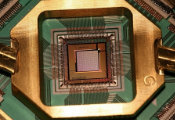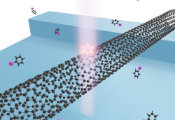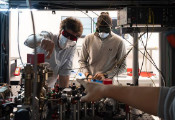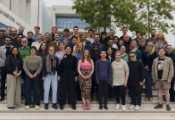On the Trail of Dark Matter: A Quantum Sensor From Jena Begins Measurements in Brazil
August 22, 2025 -- At an observatory in Brazil, a piece of Jena has arrived. Researchers from the Leibniz Institute of Photonic Technology (Leibniz-IPHT) have installed a highly sensitive measurement station there. It is intended to provide pieces of the puzzle for one of the greatest mysteries in modern physics.
When the truck finally reached the Observatório Nacional in Vassouras after its long journey, Theo Scholtes held his breath—not because of the heat that greeted him and his colleague Frank Bauer more pleasantly than expected, but because of the few centimeters of clearance between the truck and the gate wall. “Our setup had already traveled about 9,000 kilometers: by truck from Jena to Hamburg, by freighter across the Atlantic, and from Rio de Janeiro further inland. And then the very last gate before our destination turned out to be five centimeters too narrow,” Scholtes recalls.
The Brazilian research partners quickly organized a smaller vehicle, reloaded the wooden crates, and safely transported the delicate equipment into the building. This marked the beginning of the installation of a new GNOME station, part of a global network that aims to make the invisible visible.
Using Laser Light to Search for Dark Matter
GNOME stands for Global Network of Optical Magnetometers for Exotic physics searches. The project’s goal: to use laser magnetometers to detect tiny disturbances that could arise if the Earth were to pass through a field of dark matter. Around the world, highly sensitive sensors are in operation, monitoring specific quantum states of atoms and thus forming a globally distributed detector.
“Our station is based on an optically pumped magnetometer, in which we use laser light to prepare cesium atoms in special quantum states,” explains Theo Scholtes. Changes in these states—triggered by hypothetical particles such as axions—could provide clues to the existence of dark matter. The system was developed, built, and tested at Leibniz-IPHT in Jena. Key components, including ultra-low-noise current sources and laser stabilization, were specially engineered at the institute.
Measuring the Invisible
Dark matter is one of the greatest unresolved questions in modern physics. It accounts for about 80 percent of the matter in the universe, yet its exact nature remains unknown. While it cannot be seen directly, its gravitational effects influence the motion of galaxies and the large-scale structure of the cosmos. Detecting dark matter would fundamentally transform our understanding of the universe.
The GNOME stations are designed to synchronously and specifically search for very light particles—so-called axions or similar candidates—whose existence has so far only been predicted theoretically.
Sensor Technology Also Used in Medicine
Even though dark matter has not yet been directly detected, the magnetometer technology developed at Leibniz-IPHT has already proven its value in practice. In medical diagnostics, it is used in fetal magnetocardiography, a non-invasive method for measuring the heartbeat of unborn children. In geophysics, the highly sensitive sensors help detect the smallest changes in the Earth’s magnetic field and make hidden underground structures visible.
The First Station in the Southern Hemisphere
The station in Vassouras, Brazil, is a milestone for GNOME. It is the first permanently operating station in the Southern Hemisphere. For the triangulation of potential signals—pinpointing their origin with precision—this is a crucial step forward. “The geographical distribution of stations is extremely important,” Scholtes emphasizes. “It allows us to apply methods similar to those used in the detection and localization of gravitational waves.”
The Observatório Nacional, Brazil’s national metrology institute, provides ideal conditions: protection from electromagnetic interference, reliable infrastructure, and a dedicated local team. The collaboration was established within the DFG-funded project RioGNOME, acquired by Scholtes at Leibniz-IPHT.
Around the World in Two Wooden Crates
Before the station could begin delivering data, many practical details had to be arranged on-site: stable power supply, internet connection, and GPS time synchronization. The actual system—packed in two wooden crates—was reassembled and gradually commissioned by Theo Scholtes and Frank Bauer together with their Brazilian colleagues. Numerous parameters, such as laser settings, magnetic field compensation, or temperature control, can still be optimized remotely from Jena.
The greatest concern: “Whether everything really survived the long journey intact,” says Scholtes. Spare parts for many components would not have been readily available in Brazil. Yet everything worked as planned. “With commissioning, the real collaboration with the Brazilian team begins,” Scholtes says. Joint follow-up projects have already been initiated.
Thuringian Technology in a Global Network
GNOME currently consists of more than a dozen stations in over ten countries. The station developed in Jena is not only particularly robust, but also long-term stable. Variations in temperature, humidity, laser power, and magnetic field are actively regulated. “We were able to draw on our extensive experience from our GNOME station in Moxa,” Scholtes explains. In that small town in Thuringia, Leibniz-IPHT and Friedrich Schiller University Jena have been operating a GNOME station for several years—shielded from urban interference and ideally equipped for long-term precision measurements.
The new station was built together with the Brazilian Observatório Nacional in Vassouras, at a geophysical observatory with existing infrastructure, protected from magnetic noise, and continuously supported by scientific staff.
Knowledge from Thuringia for Research and Medicine
The Jena researchers were able to rely on their extensive experience with the setup and operation of the GNOME station in Moxa. There, Leibniz-IPHT has been working with Friedrich Schiller University Jena for several years on long-term precision measurements. Many operating parameters—such as laser settings, magnetic field compensation, or temperature control—can now also be adjusted remotely from Jena in Brazil.
Commissioning also marks the start of a new scientific partnership with the Brazilian Observatório Nacional, which is expected to continue with future joint projects.
The magnetometer technology developed at Leibniz-IPHT shows its potential not only in fundamental research. In medical diagnostics, it is used for the non-invasive measurement of fetal heartbeats. In geophysics, it helps detect minute changes in the Earth’s magnetic field and reveal hidden geological structures.




































